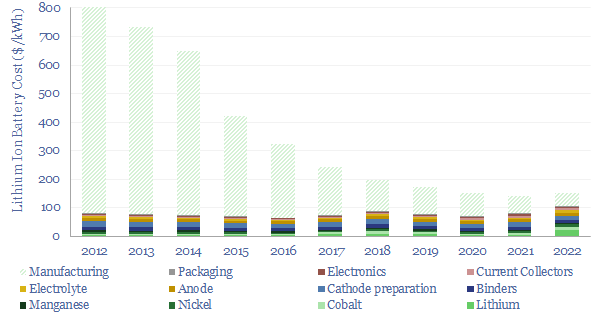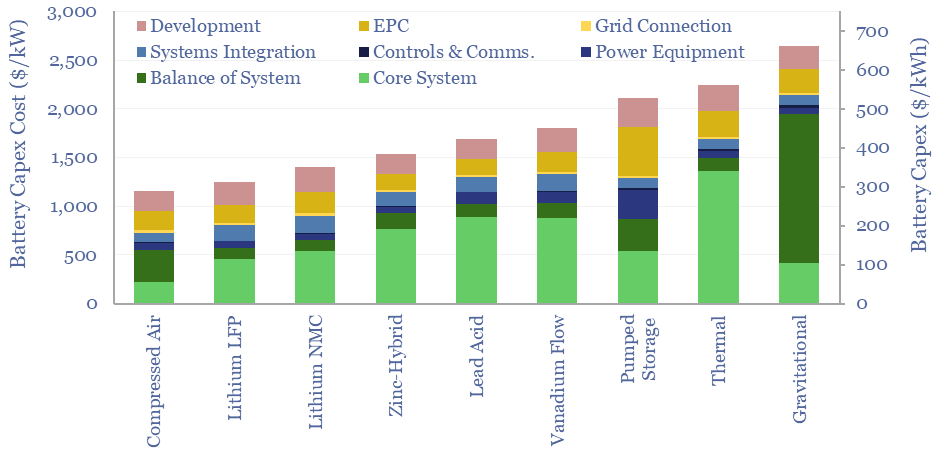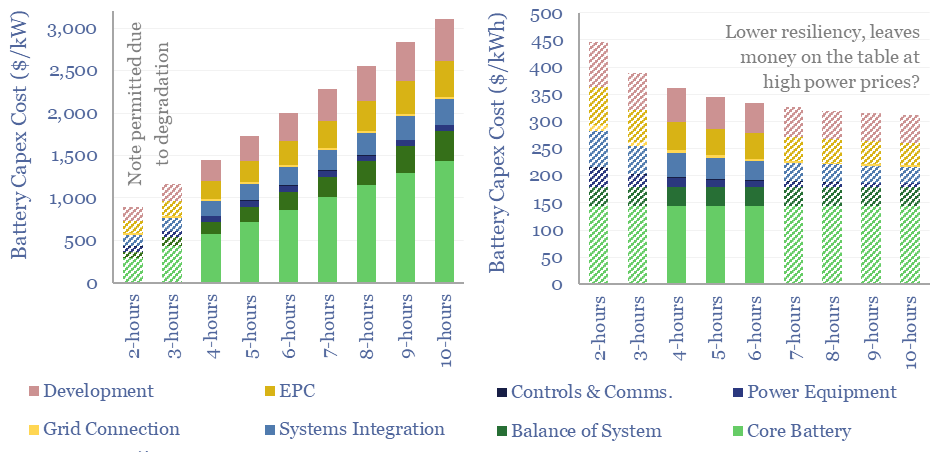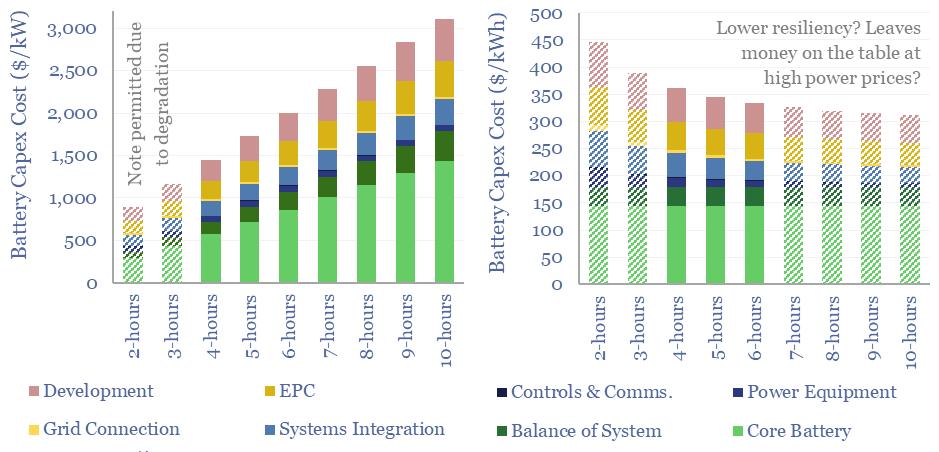Grid-scale battery costs can be measured in $/kW or $/kWh terms. Thinking in kW terms is more helpful for modelling grid resiliency. A good rule of thumb is that grid-scale lithium ion batteries will have 4-hours of storage duration, as this minimizes per kW costs and maximizes the revenue potential from power price arbitrage.
Quantum mechanics asks us to think of the electron as both a particle and a wave. Despite the obvious fact that a particle is not a wave, and a wave is not a particle. This is probably a reason that most people do not love quantum mechanics.
Battery models similarly ask us to think about a battery as a ‘per kW’ device and as a ‘per kWh’ device. Where 1 kWh is the supply of 1 kW for precisely 1-hour (or some similar multiplication, such as 0.5 kW for 2-hours, or 0.25 kW for 4-hours, per our overview of energy units). Clearly, kW are not kWh and kWh are not kW.
Our own grid-scale battery model is guilty of this dualistic behaviour, quantifying the costs of grid-scale batteries both in $/kW terms and in $/kWh terms. Our view is that it makes marginally more sense to think about a grid-scale battery in kW terms, when modelling the costs of integrated power systems. But there is some flexibility.
Standalone batteries in kWh terms?
Battery costs are often quoted in $/kWh on a standalone basis, tabulated here, charted below, and showing the amazing deflationary profile of moving the mass manufacturing of batteries over the past decade and leaving mostly material costs (note the units of the y-axis).

Especially in the realm of electric vehicles, this is the cost at which battery packs tend to be procured, for integration into a vehicle. And $/kWh is the most relevant cost metric when thinking about the enormous impending ramp-up of EV batteries.
Grid-scale systems in kW terms?
The output from a battery module is DC electricity at a voltage level driven by electrochemistry. However, circuits in the power grids consist of AC electricity at a very specific and pre-defined voltage. Hence power electronics are required to connect a battery into the grid.
An inverter containing multiple layers of MOSFETs is used to synthesize an AC sine wave from the DC output of a battery. Inverters are sized in kW terms, and priced in kW terms.
A transformer then steps up the voltage of the AC electricity to whatever level is required by the specific grid loop downstream. Transformers are sized in kW terms, and priced in kW terms.
A physical connection is then made between the step-up transformer and the circuitry of the power grid, using cables and other power electronics. These connections are usually rated in kW terms and their costs are best quantified in $/kW terms, or even per kW-km of transmission and distribution distance.
Resolving Duality: $/kW or $/kWh?
When we add up the total installed costs of a grid-scale battery, about 40% is the core battery, best measured in $/kWh; another 30-40% is the power electronics and grid connection, best measured in $/kW; and the remainder includes costs such as engineering, permitting, land-leasing, construction, which are best measured in absolute $ terms.
It is a philosophical choice how to present battery costs. You can add all of the cost lines together (in $) and divide them by the total power rating in kW (yielding a $/kW metric). Or you can add all of the cost lines together (in $) and divide them by the total energy storage in kWh (yielding a $/kWh metric).
Our own capex numbers are tabulated below for different systems, assuming that each one stores 4kWh of electricity per kW of rated storage capacity. This is not to say that all batteries must have 4-hours of storage, but just a simplification to enable apples-to-apples cost-benchmarking.

Energy storage and power ratings can be flexed somewhat independently. You could easily put a bigger battery into your lithium LFP system, meaning the costs per kWh would go down, while the costs per kW would go up; or you could connect your LFP battery to a bigger inverter and transformer, meaning costs per kW would go down, while costs per kWh would go up.
“Somewhat independently” and the 4-hour battery?
A limitation of lithium batteries is that the faster you charge them and discharge them, the faster they degrade. The reasoning is explained in the note below. But in short, when a battery is charged and discharged, lithium ions physically need to move through the cell, intercalating and de-intercalating from electrodes. The faster you push this process, the more side-reactions will occur.
For safe and long-lasting batteries, it is recommended not to exceed a 0.25 C-rate. This means that no more than 25% of the battery’s total electricity storage will be cycled per hour. Or in other words, the charge time of a lithium ion battery should not be less than 4-hours, and the total discharge time at full capacity should be 4-hours. Faster charging and discharging are possible, but they may invalidate the battery’s warranty.
Grid modelling: why we prefer kW and $/kW metrics?
When we start modelling the integration of renewables into power grids, we are looking at grid loads (in MW) supplied moment to moment by different power generation sources (in MW). If a cloud passes over a solar array, or if some large power plant trips out during a heatwave, then the grid is going to be short of MW. If the grid does not have capacity to rapidly add MW, then the grid is going to fall over. This is why we care predominantly about batteries producing MW.
Grid-scale batteries will tend to minimize duration?
Today, sizing batteries is mostly about ensuring resiliency of the grid. Hence companies developing wind and solar, or consumers using wind and solar, tend to focus on the MW capacity ratings of batteries. And longer duration lithium ion batteries become more expensive on a $/kW basis (as they need to contain more battery cells priced in $/kWh).

Costs per unit of energy storage do fall as battery duration increases. The reason is that you are adding more battery cells priced in flat $/kWh terms, while other $/kW cost lines are being amortized across more energy storage. But is this leaving money on the table, in a way that will tend to incentivize building out the power electronics too?
It is 7-8pm in California. Power prices are high. And you have stored 100kWh in your battery. You really want to fill the gap at 7-8pm. If you can discharge all 100kWh at 8pm, that is going to generate the best economic results. But if you have undersized the power-electronics, and can only discharge 10kWh at 8pm, then money has been left on the table.
The old adage in traded commodity markets, is that the majority of the profit potential comes in the volatility, not in the core day-to-day spread. It does not cost materially more (in $/kWh terms) to build out the power electronics and buy the capability to run batteries at a 0.25C charge/discharge rate. It also helps to ensure resiliency.
Overall we still think most grid-scale lithium batteries will aim at around 4-hours of duration. At longer duration, we prefer redox flow batteries among electrochemical solutions. Even better backups are thermal energy storage and demand shifting. While for economic reasons, we think clean natural gas turbines will ultimately end up being the most widely used backup for renewables’ volatility.

